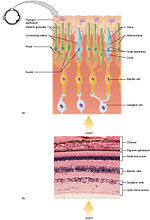Rod cells are photoreceptor cells in the retina of the eye that can function in lower light better than the other type of visual photoreceptor, cone cells...
14 KB (1,752 words) - 00:37, 28 June 2024
in mammalian eyes: rods, cones, and intrinsically photosensitive retinal ganglion cells. The two classic photoreceptor cells are rods and cones, each contributing...
26 KB (2,937 words) - 05:37, 25 July 2024
Depolarization (section Rod cells of the eye)
nerves associated with rod cells. This cycle is broken when rod cells are exposed to light; the absorption of light by the rod cell causes the channels that...
19 KB (2,361 words) - 14:39, 18 August 2024
to rod cells, which work better in dim light, or the scotopic region. Cone cells are densely packed in the fovea centralis, a 0.3 mm diameter rod-free...
16 KB (1,938 words) - 11:34, 23 August 2024
Scotopic vision (redirect from Rod cell vision)
cells – the output neurons of the retina. Instead, two types of amacrine cell – AII and A17 – allow lateral information flow from rod bipolar cells to...
11 KB (1,197 words) - 19:02, 8 August 2024
treatment. In general, PRAs are characterised by initial loss of rod photoreceptor cell function followed by that of the cones and for this reason night...
12 KB (1,584 words) - 00:02, 18 August 2024
up rod or Rod in Wiktionary, the free dictionary. Look up ród, röd, rød, or roð in Wiktionary, the free dictionary. Rod, Ród, Rőd, Rød, Röd, ROD, or...
3 KB (552 words) - 07:30, 16 May 2024
As a part of the retina, bipolar cells exist between photoreceptors (rod cells and cone cells) and ganglion cells. They act, directly or indirectly, to...
6 KB (742 words) - 06:44, 18 July 2023
types of higher-intensity light receptors (called cone cells in vertebrates as opposed to rod cells, which are lower-intensity light receptors) with different...
25 KB (2,713 words) - 05:24, 20 August 2024
progressive loss of rod photoreceptor cells that line the retina of the eyeball. The rod cells secrete a neuroprotective substance (Rod-derived cone viability...
63 KB (6,440 words) - 22:03, 21 August 2024
constitute a third class of photoreceptors, in addition to rod and cone cells. Compared to the rods and cones, the ipRGCs respond more sluggishly and signal...
26 KB (3,118 words) - 05:44, 25 July 2024
human rod cells, these events occur about once every 100 seconds on average, which, taking into account the number of rhodopsin molecules in a rod cell, implies...
6 KB (620 words) - 18:25, 21 August 2024
standard dry cell comprises a zinc anode, usually in the form of a cylindrical pot, with a carbon cathode in the form of a central rod. The electrolyte...
7 KB (831 words) - 05:32, 14 August 2024
Ursodoxicoltaurine (section Photoreceptor cells)
This caused a considerable preservation in cone cell amount and function at P50, and a modest rod cell amount at P30. In the albino mice models, intraperitoneal...
16 KB (1,566 words) - 12:34, 5 August 2024
Since cone cells are not as sensitive to dim light as rod cells, most night vision is limited to rod cells. Likewise, since cone cells are in the fovea...
106 KB (12,873 words) - 10:51, 11 August 2024
Monochromacy (redirect from Rod monochromat)
scotopic vision is monochromatic, since there is typically only one class of rod cell. However, the presence of multiple cone classes contributing to photopic...
12 KB (1,453 words) - 09:06, 21 July 2024
Pteropus species do not. All species examined had retinae with both rod cells and cone cells, but only the Pteropus species had S-cones, which detect the shortest...
123 KB (13,410 words) - 09:23, 28 June 2024
epithelium Cells Photoreceptor cells (Cone cell, Rod cell) → (Horizontal cell) → Bipolar cell → (Amacrine cell) → Retina ganglion cell (Midget cell, Parasol...
2 KB (211 words) - 19:21, 4 January 2023
are found in the photoreceptor cells in the retina of eye. The opsin in the vertebrate rod cells is rhodopsin. The rods form disks, which contain the rhodopsin...
33 KB (3,318 words) - 18:27, 22 August 2024
sildenafil to diminished enzyme activity, thereby sensitizing the retinal rod cells. Rod cells are most sensitive to light of wavelengths near 498 nm; such light...
4 KB (431 words) - 16:29, 8 August 2024
rods (cells which detect dim light in black and white) in the fovea: a small area in the center of the eye. The fovea contains primarily cone cells,...
5 KB (626 words) - 02:31, 23 March 2023
retina. Contributing to vision, the retina contains the photosensitive rod and cone cells and associated neurons. To maximise vision and light absorption, the...
21 KB (2,746 words) - 18:34, 15 June 2024
consisting of both rod cells and cone cells, which are the photoreceptor cells for two parallel but mostly separate visual systems. The rods enable the scotopic...
6 KB (742 words) - 13:29, 29 July 2024
amacrine cells synapse with retinal ganglion cells. The synapses in the outer plexiform layer are between the rod cell endings or cone cell branched foot...
2 KB (142 words) - 21:13, 21 November 2021
Adaptation (eye) (section Cones vs. rods)
see under low-light conditions. In humans, rod cells are exclusively responsible for night vision as cone cells are only able to function at higher illumination...
47 KB (5,790 words) - 11:44, 26 April 2024
Zinc–carbon battery (redirect from Carbon zinc cell battery)
typically constructed as a cylindrical container for the battery cell, and a carbon rod surrounded by a compound with a higher Standard electrode potential...
16 KB (1,753 words) - 07:11, 18 July 2024
cause blindness in humans. RP begins with death of rod photoreceptor cells, which are the only cells in the retina to express rhodopsin and which express...
38 KB (4,009 words) - 11:01, 3 December 2023
eyes of nocturnal animals have a greater percentage of rod cells. In most mammals, rod cells contain densely packed DNA near the edge of the nucleus...
68 KB (7,578 words) - 08:44, 24 August 2024
presented to an area of the right eye where there is a high density of rod cells, 20 degrees to the left of the point of focus (i.e. 20 degrees to the...
16 KB (2,071 words) - 21:06, 26 June 2024





















